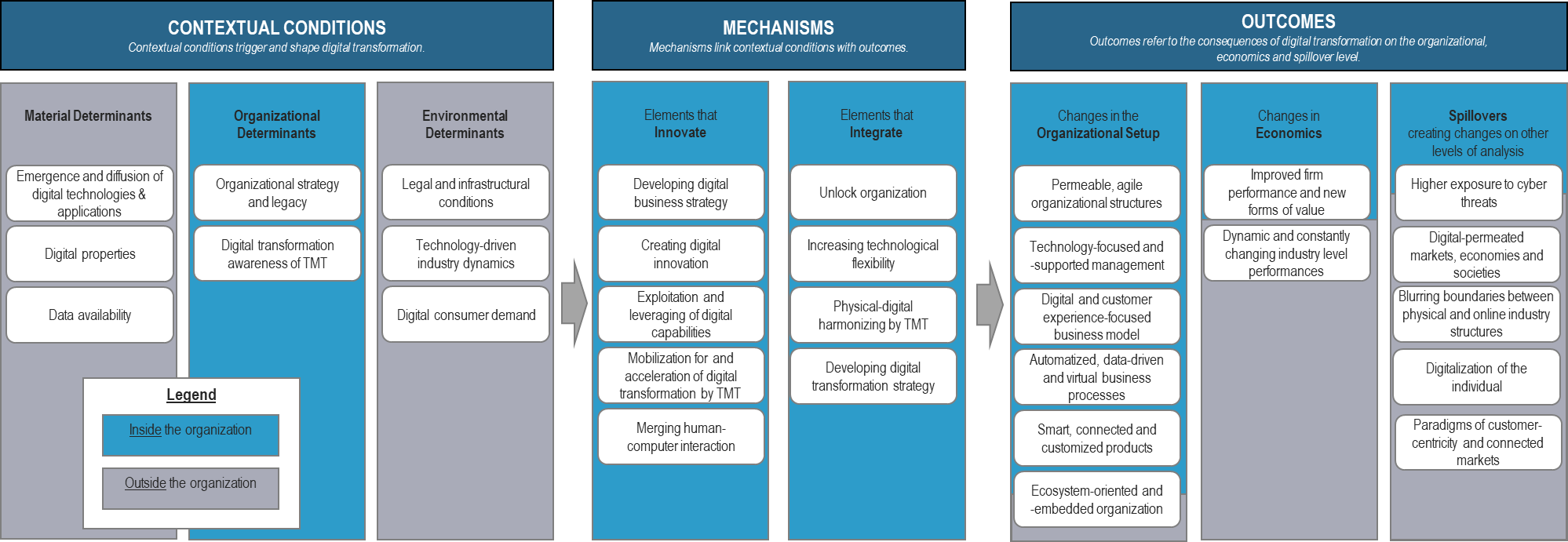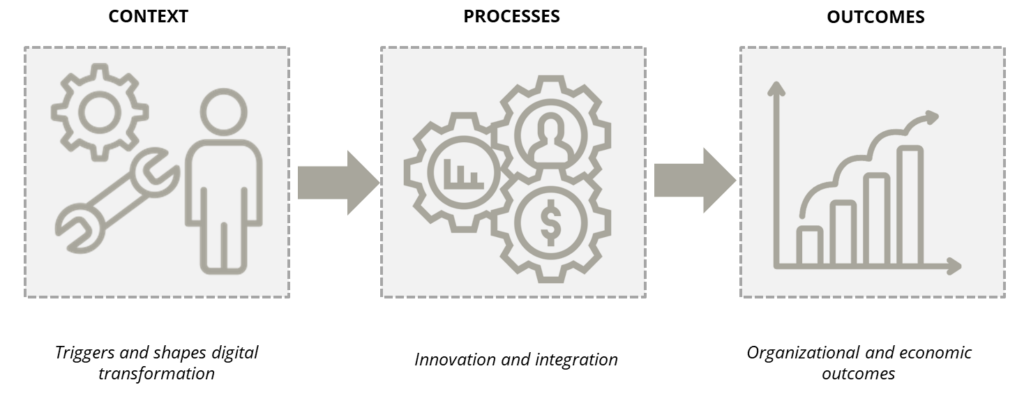What is Digital Transformation? – Definition and a Framework for digital Change
Not sure what digital transformation means? Here you will get to know key characteristics of digital transformation and relevant steps to have a successful organizational change!
Based on a recent study, this article provides a definition for digital transformation and will introduce you to the three key ingredients to a successful digital transformation framework. Implementing digital transformation is most certainty not easy and different challenges will arise from trying to achieve a substantial change. Learn here the leadership skills required for this process and everything else you need to commence your digital journey.
Interest in digital transformation has been dramatically increased and received a tremendous boost through Covid 19. Take any organization and you’ll find digital transformation at the top of priorities. But the thing is, this topic is so broad that most managers seem out of depth while talking about it. Why?
Mainly because the term digital can mean many different things to different people. It can be anything from adopting new technologies to introducing automated operations. In addition, the term transformation is actually a synonym of change. How can you define something that means “Change”? Well, when you combine these two words, you’ll get an enigma, which has been hard to solve, including senior management personnel.
That’s why this article, based on a recent scientific publication which reviewed 279 studies on digital transformation (see study here), covers (almost) everything you need to know about digital transformation, what it is, the key ingredients of a successful digital transformation framework, and the potential leadership skills you might need.
Index
What is Digital transformation?
The short version is:
Digital transformation is organizational change that is triggered and shaped by the widespread diffusion of digital technologies.
This definition offers us an insight that digital transformation is a process with input (diffusion of digital technologies), processes and an outcome (organizational change). Below you see an overview of all elements and dimensions that play a role in digital transformation. But let’s look into detail.

Multidimensional Framework of Digital Transformation
Digital transformation involves numerous things and is a much more complex process as otherwise suggested by some. There is a common misconception that digital transformation simply means adopting new tech. Although partially true, there are many other things to consider to fully understanding the framework of digital transformation.
For a better understanding, here’s a breakdown of the entire process detailing each phase of digital transformation.

1. Context – the driving force of digital transformation
Context – within the organization and outside – is the initial phase of digital transformation, which triggers and shapes it. Digital transformation begins with the awareness of the top management team and acknowledging the need to change. This awareness is generally inspired by external and internal organizational factors, which are described below.
a) Internal factors
All businesses strive to enhance efficiencies of operations, introduce cost-cutting tools, maximize their profits, and more often than ever, digital transformation can play a crucial role in achieving these business objectives of the top management. For example, new digital technologies are considered the top internal factors that are affecting the digital transformation process. Furthermore, the increasing availability of data is driving digital transformation. At the same time, there are also hampering forces, such as legacy investment in machines that are not depreciated yet or software for which you have long contracts.
b) External factors
Nowadays, industry dynamics and the ever-so-changing consumer behavior are the two biggest external factors that trigger digital transformation. Thanks to the current advancements in the digital world, consumers (think Gen Z), expect every business to have some sort of digital presence and this expectation is the biggest factor forcing businesses to modernize their operations and interact with their customers digitally. It’s no longer a luxury for businesses to adapt digitally, instead, it has become a necessity.
All in all, digital transformation begins with the thought of how to improve existing operations. And at this moment, is quite clear that there are several reasons forcing the top management to consider digital transformation.
2. Processes
The second phase of digital transformation involves the top management taking action. Basically, two equally important mechanisms are necessary to bring on digital transformation: innovation and integration. These two mechanisms are used to overhaul the existing redundancies in the operations and to transform them into ones that are more efficient as well as exploring new avenues to interact with consumers digitally.
Below, the way these two mechanisms work is explained:
a) Innovation
As the name suggests, this process revolves around creating a digital business strategy based on data insights of the consumers and overall industry dynamics. The core focus of the management here is to innovate existing operations by integrating new digital products, making use of the internet of things (IoT), and exploring different business models.
Once this digital business strategy is finalized, the next step involves the onboarding of the personnel because successful digital transformation requires harmony between the staff and top management, otherwise the change will not be effective.
Not least, the innovation mechanism is also about creating meaningful human-machine interaction as a core activity to establish value-adding synergies (think particularly about UI/IUX).
b) Integration
Integration mechanism comprises aligning the new elements of the digital business strategy with the existing business operations and unlocking that “change mindset”.
This mechanism revolves around creating a transformational strategy that acts as a foundation to integrate the entire coordination, prioritization, and implementation of digital transformation and this is where organizations really start to see the impact of the changes implemented.
3. Outcomes
This is the final phase of digital transformation where all plans and strategies created in the earlier phases come to fruition. The digital transformation effects can be seen from within the organization in terms of changes in processes, adoption of new tech, new business models, etc. to outside of it in terms of how organizations that are part of the digital business ecosystems affect society. This involves cyber threats, digitalized individuals and the general trend towards the digital economy.
The change of management style is also evident in this phase as the previous “chained mindset” of the organization has now been broken, resulting in modified business operations and the adoption of new business models, more agile organizations, data driven processes, smart connected products and companies thinking in terms of ecosystems rather than linear supply chains.
All these different phases clearly indicate that digital transformation is a complex multi-dimensional and multi-stage process; and if an organization is considering digital transformation, it requires the top management to have a well-defined framework in advance to avoid any negative outcomes during the process but also the necessary leadership skills. Let’s take a closer look at those.
Leadership skills required for implementing digital transformation:
Any significant change comes with its own challenges and usually, the organization implementing the change has to face a lot of resistance in the beginning. The same applies to digital transformation. Therefore, successful implementation of digital transformation requires the following three leadership skills.
1. Awareness
The entire premise of digital transformation is based on the awareness of the top management and acknowledging the need to change. As such, awareness might be the most crucial skill that plays an integral part in digital transformation.
The managers must have a data-driven mindset and should be aware of the changing environment such as industry dynamics, consumer demands, and also unexpected circumstances as the current pandemic situation. The managers must also be aware of emerging technologies and their properties, and how organizations can benefit from them to gain a competitive advantage.
2. Acceleration
Digital acceleration refers to the intellectual capacity of managers to continuously conceive novel digital processes based on the resources available and to ensure that the strategies made by the top management are being followed.
This potential skill is basically connected to the innovation mechanism. Therefore, managers must have the capacity to implement and execute digital business strategies in the need of the hour. Instead of long planning processes, as it used to happen most of the times, managers must be willing to experiment and rapidly adapt to circumstances in order to bring about digital transformation.
3. Harmonizing
The last skill, harmonizing, is associated to the integration mechanism from the multi-dimensional framework of digital transformation, and requires the managers to integrate new digital products and processes within the existing operations of the organization.
As an important change agent, managers must also be able to bring together the old “physical business units” with the new digital business units and reconcile any differences that might occur during the transformation process.

In sum, successful implementation of digital transformation requires time and effort and most importantly, organizations considering a change should have managers with the above-mentioned skills to master the challenges of digital transformation and to benefit from its results.
Wrapping it up
Digital transformation is a multi-level phenomenon and on a managerial level, it is crucial to understand this process in order to create a framework for digital transformation and implement the change successfully. Above all, the top management team should have the awareness of the changing environment as well as an open mind to identify the gaps in the existing operations, the capacity to accelerate the execution and experimentation of new processes, and the ability to harmonize all of these in the existing organization. And remember, once you commence your digital journey it will never stop.

Comments are closed.